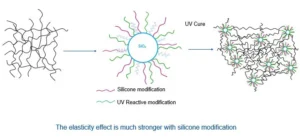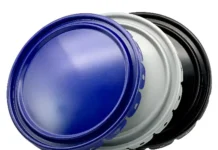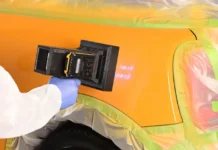By Mike Toth, BYK USA
In today’s throwaway society, a product that demonstrates quality and longevity is not only an anomaly, but a seemingly fortuitous outcome. In many industries, supply chain disruptions and logistical challenges have impacted the ability to obtain necessary products. Worst-case scenarios from supply breakdowns can lead to product recalls or poor-quality offerings that have significant financial impact. In a post-COVID era, formulating pugilists (a.k.a. chemists) are in a “virtual arena,” fighting this battle to ensure they have the highest quality and performing ingredients available to meet market trends and demands. Author Gary Vaynerchuk said, “There is no sale without the story – no knockout without the set-up.” This statement rings true when related to the use (set-up) of high-performing ingredients in UV radiation-curable coating systems. When concocting a coating formulation, consider the use of cross-linking surface additives to adjust surface tension and provide excellent substrate wetting, leveling and scratch boosting performance. Additionally, consider the use of nanoparticle dispersions and micronized wax additives to deliver a formulation “knockout” by significantly boosting abrasion and scratch resistance. The incorporation of highly specialized small particle size additives into industrial coating formulations provides superior mechanical resistance without negative impact to critical to quality (CTQ) features like substrate wetting, flow, gloss stability or clarity of a coating, therefore creating a product that exhibits premium results that outlast and outperform lesser quality additives.
Review of Basic Surface Properties and Theory
Before discussing the potential for high-quality surface-improving additives, it is important to have a firm grip on basic principles of surface theory and a better understanding of how additives impact – positively or negatively – the performance of the coating film. Ensuring proper substrate wetting, or the ability of a paint or coating to “wet out” a substrate, is among the first features to consider when constructing a coating formulation. Surface tension of the coating easily can be adjusted with acrylate and silicone-containing additives. Simply put, a coating must properly and efficiently “wet out” a substrate.

Rule #1: Higher surface tension equates to better leveling. Substances with high surface tension (like mercury at 484 mN/m) will seek to attain the smallest surface area possible. Having the smallest surface area possible at a given volume equates to the best leveling functionality. Therefore, due to strong cohesive forces on the high surface tension of mercury, it forms “lenticular” droplets that do not properly wet out the substrate but instead exhibit excellent self-leveling properties (Diagram A).

Rule #2: If improved substrate wetting features of the coating are desired, then surface tension of the coating must be lower or equal to the surface energy of the substrate. However, the key lesson here is to adjust surface tension only as low as necessary, but not as low as possible! Why is this the case? In the System #2 illustration (Diagram B), adjusting surface tension slightly under 30 mN/m to 29 mN/m gives very effective substrate wetting with good flow and acceptable leveling. A surface tension too high above the surface energy of the substrate (System #1) will result in poor flow and terrible “wet out” of the substrate. In contrast, as shown in System #3, adjusting surface tension too low under the surface energy of the substrate results in rapid and efficient substrate wetting, but at the expense of poor flow and leveling.
Introduction of Cross-Linking Surface Additives
Cross-linkable, silicone-containing, surface-tension-adjusting additives provide scratch-resistant, oleophobic and easy-to-clean features. These reactive surface additives can be cross-linked into an acrylate UV resin matrix, providing long-lasting efficacy that will not significantly degrade over time like non-reactive additives that lose potency. Many of the reactive silicone surface additives are designed to reduce co-efficient of friction (COF), thus increasing slip. Slip is the ability of objects to “glide” over a coating surface. It reduces damage causing impacts that leave scratch and abrasion marks.
Design Structure

Reactive surface additives contain single or multiple reactive groups in the structural backbone to make it cross-linkable. The silicone part (shown in Diagram C in royal blue color) orients to the surface. The linker parts (shown highlighted in dark blue and light blue) adjust compatibility to the reactive groups. The acrylated reactive groups make it cross-linkable with the UV binder matrix. It is very important that the additive remains active and oriented at the surface, providing permanence in the coating film. The higher number of functional groups a cross-linking surface additive contains, the higher the likelihood of achieving full cross-linking into the coating matrix. The more linear and longer the silicone chain, the stronger the reduction in surface tension, and the greater the slip and easy-to-clean functionalities. If stain resistance and surface cleanability is sought, then it is important to have a hydrophobic (water repellent) and lipophobic (oil repellent) balance integrated into the cross-linking structure. First generations of UV acrylate surface additives often were dark brown in color and had pungent odors. These pioneering cross-linkable surface additives generally were limited for use in non-white pigmented systems due to the color impact on both transparent and pigmented white or light color systems. However, advances in manufacturing and chemical processing to subsequent generations of cross-linking surface additives are not stressed by temperatures or pressures. This modern process enables additives to be both colorless and odorless, and therefore, they can be incorporated into ultra-clear water-borne UV, solvent UV and solvent-free UV topcoats, as well as white pigmented coatings.
Cross-Linking Slip Additives

For some industrial or consumer applications, it is important to note that products that offer too much surface “slip,” like hardwood flooring or baseball bat handles, could be detrimental and potentially dangerous. To counteract slip, there are both reactive and non-reactive silicone-free options (Diagram D). These siloxane-free, often hyperbranched structures, embed nicely into the cross-link density of a UV coating, which also has positive impact on surface leveling. Additionally, the increased surface tension at the coating substrate interface can improve both recoatability and intercoat adhesion, even in water-borne UV systems. Formulator exploration at higher dosages often can lead to anti-slip properties which can be a remarkable feature for the aforementioned markets. The reactive class of cross-linkable surface additives often have little impact on clarity or haze in coatings, but gloss stability always should be checked. In summary, cross-linkable surface additives, both silicone and non-silicone, offer robust surface-enhancing performance in many types of coating technologies. These include solvent-free, solvent-borne, aqueous and radiation-curable systems.
Nanoparticle Dispersions for Extreme Surface Durability
What exactly is a nanoparticle, particularly as it relates to paints and coatings? Nanoparticles are extraordinarily small particles dispersed into a liquid medium. These miniscule particle sizes are measured in nanometers, which range from 1 nm to 100 nm. To put this in perspective, the thickness of a DNA strand is 2 nm, which is undetectable to the human eye, whereas the average thickness of human hair is 75 microns which is the detectable size limit of the human eye. To provide scale in length, 75 microns (or micrometers) is equal to 75,000 nanometers. It is hard to comprehend the number of nanoparticles that can be imbedded into a coating film.
As previously mentioned, an efficient method to improve mechanical resistance of a coating is by the incorporation of cross-linking silicone additives that decrease surface tension and increase slip of UV coatings. However, in situations where ultimate mechanical resistance without increasing slip is desired, and when controlling gloss and optical properties are a must, the use of premium nano-dispersion-based liquid surface additives containing nano-aluminum oxide or nano-silica oxide should be explored. For these nanoparticles, carrier delivery systems in water, solvent and monomers are available commercially to satisfy the needs of diverse UV coating technologies. As a general rule, before using nanoparticle additives to boost surface properties, other surface additives contained in the formulation should first be removed, especially highly active silicone containing defoamers and surfactants. Then, once surface protection needs are met, add silicone additives back into formulations as needed in order to adjust surface tension, substrate wetting, flow and leveling properties of the coating. Additionally, it is recommended to always mix nano-based additives well before use. Then incorporate nanoparticle additives for longer duration rates and at lower mixing speeds to ensure sufficient distribution and uniform spread into the resin, clear topcoat or coatings.
The use of nano-based surface additives is applicable to many markets. They are perfect for use in automotive interiors and exteriors, as well as with plastic, glass, wood and metal substrates. They offer the highest level of scratch and abrasion resistance by significantly improving the hardness of the coating film without negative impact to optical features like gloss, haze or transparency in clear coats. Several types of reactive and non-reactive silicone and silicone-free nano-particle additives exist.
First, silicone-free nano particle dispersions containing nano-aluminum oxide particles form an extremely hard film and provide the highest scratch and abrasion resistance properties. The use of siloxane-based additives can be used in conjunction with nano-aluminum oxide to increase surface slip of the coating if desired.

Next, modern-day advancements to nano-silica technology achieve improved surface hardness. An additional benefit is flexible shock-absorption (also referred to as a “spring” or “rebound” effect). It cushions the blow of an impact and diffuses that energy across the coating film rather than cause surface defects (Diagram E). This effect is accomplished by special modifications. These adjustments specifically tailored to both the silicone chain and reactive groups help lower cross-linking density around the core shell structure, thus creating microscopic “space.” In layman’s terms, the “space” – or large areas of polarity difference that are created around the nano-silica particles – acts as a micro shock absorber, which results in the development of not only a significantly harder film but provides for the unique benefit of flexibility to the coating film. This technology especially is effective in very hard resin systems. Today, the use of nano-silica and nano-alumina type particles are available for use in water-borne, solvent-borne and 100% solvent-free UV coatings. Nanoparticles for solvent-free UV also are available prediluted in commonly used monomers like HDDA and EO-TMPTA, in order to make them solvent-free.

Particularly on substrates that are designed to flex (including plastics, vinyl or even cross-laminated timber), the use of modified cross-linking nano-silica oxide can provide a benefit by combining surface-boosting scratch resistance and film hardness, while improving film elasticity on these critical and flexible substrates. Yet another tremendous advantage of this technology is integrated into 100% UV coatings that are applied onto vinyl or plastic films used in the flooring, automotive and aerospace industries. The result is significantly reduced “edge curl” from reduced shrinkage and relaxation of the film (Diagram F).
Introduction of High-Performing Micronized Waxes
Another surface enhancer is found in the incorporation of wax-based additives – specifically, waxes delivered in a micronized, or milled, powder form, which provides easy incorporation into coating formulations. Micronized waxes can improve surface hardness and offer lubricity to the surface. On a microscopic level, wax particles can protrude out of the surface and act as a lubricator to help harmful impact forces “glide” across the coating surface instead of deforming it. Although micronized waxes are not technically cross-linked into UV binders, the small particle size of micronized wax can be “locked into” or captured into the cross-link density, which positively can contribute to surface hardness of the coating. In addition to surface hardness, which boosts scratch and abrasion performance, some grades offer positive features like reduction of COF (increasing slip) and haptic soft-touch features, and some grades can contribute to texturing and/or matting effects. In fact, many of the micronized waxes can be fantastic partners to silica-based matting agents, which offer easier incorporation, less “dusting” due to the higher bulk density of particle sizes compared to silica particles and tend to be less “gritty” in the final formulation, contributing to an improved haptic feel. Specific grades of micronized wax products exist that are considered “universal” grades. In other words, they are compatible to perform effectively in water-borne, solvent-borne and solvent-free radiation-curable coatings. The robustness of micronized wax additives is a great feature that can help reduce complexity of additives that formulators keep on their shelves and reduce the need for supply chain professionals to stock additional products (SKUs). There are cost-effective, commercially existing and bio-friendly micronized waxes available. In today’s world, any simplification of the supply chain can be a great win.
PTFE-Free Micronized Wax Performance

Perhaps the ultimate high-performing micronized waxes are those that contain Teflon® or PTFE. Polytetrafluoroethylene (PTFE) -containing waxes have excellent anti-scratch performance, but are frowned upon by global regulatory agencies due to PFAS (polyfluoroalkyl) -containing substances. A new generation of PTFE-free waxes, but with similar PTFE performance properties, recently has been introduced to market. These PTFE-free waxes use higher-density wax chemistries and conceptually are designed to provide PTFE-like performance for mechanical resistance. The higher density particles imbed into and throughout the entire coating film just like their PTFE-containing counterparts. Henceforth, orientation of the micronized wax particles is more uniformly distributed in the entire liquid film vs. only the air-liquid interface as traditional non-containing PTFE micronized waxes (Diagram G). The advantage of this is specifically tailored micronized offerings that have similar mechanical resistance, anti-abrasion and anti-scratch performance, improved slip and minimal impact to gloss when incorporated into clear topcoats (Diagram H). To achieve very low COF, the exploration with blending of Carnauba wax-based chemistries can be explored. Additionally, when used in metal coatings, this new generation of PTFE-free performance shows excellent self-leveling properties in can coatings.
Bio-Renewable Micronized Wax Options

Another classification of micronized wax-based chemistry is based on bio-renewable sources. First-generation micronized biopolymer-type waxes offer some excellent features, such as soft-touch haptics, optical clarity, reduced haze and matting effects. They generally were not designed to significantly boost anti-scratch and abrasion resistance in coatings. In the near future, next-generation advancements will be commercially available that focus on raw materials generated from 100% renewable sources and, most importantly, will offer significant improvement in boosting mechanical-resistance properties. Moreover, for industrial wood coatings, this new generation of renewable micronized wax additives will compliment current wood industry furniture trends to more environmentally friendly, formaldehyde-free substrates made from repurposed bio-waste, which include rice, corn or hemp plants.
Conclusion
Despite current supply chain challenges plaguing nearly every industry, including UV radiation-curable products, premium performance additives are available. They provide cross-linkable performance, use extremely durable nanoparticles and include varying grades of micronized wax technologies. These additives provide next-level surface durability and performance features that end users demand. When “on the ropes” and working on improving or qualifying new additives in formulations, chemists may require a versatile and trusted team in their corner. The team, in this case, is adaptable cross-linking surface additives, surface-boosting nano-particle dispersions and high-performance micronized wax additives. These ingredients, used together or individually, will help formulators land that “combination one, two knockout punch.”
Note from the Author: The author would like to specifically thank colleagues from BYK’s GI Metal, Industrial Wood, Automotive, and Marketing teams for their collaboration and support of this article.
References
- BYK E-Learning Books, “Surface Additives,” Section 6, Substrate Wetting, https://www.byk.com/en/service/ebooks/surface-additives#substrate-wetting
- Excellent Coating Surfaces: The Right Additive Cocktail to Success. Marcel Krohnen, BYK-Chemie GmbH, Istanbul, February 13, 2019
- BYK Seminar: Surface Additives for Graphic Arts, Elizabeth Kaufman. BYK-USA, Wallingford, CT. October 05, 2020
- Two Approaches to Improve Substrate Wetting of Aqueous Coatings. Janos Hajas Guillaume Jaunky Michael Bessel, Mark Heekeren & Brigitte Weber, BYK-Chemie GmbH, Wesel, Germany 2017







